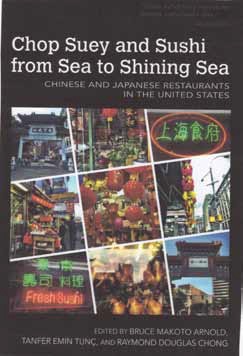|
Read 13091433 times
Connect me to:
|
Chop Suey and Sushi from Sea to Shining Seaby: BM Arnold
Tung, TE and Chong, RD
Fayetteville AR:
University of ArkansasPress, Hardbound
Reviewed by: Jacqueline M. Newman
Winter Volume: 2018 Issue: 25(4) page(s): 19
 Funded in part by the Julia Child Foundation, this
collection of thirteen essays and its introduction are
heavily weighted toward Chinese food and facilities.
Ten are by a single author, three by two of them, the
Introduction by just one author. Two are focused on
Japanese food and facilities, three Asian-fusion related,
the rest have a Chinese focus.
Funded in part by the Julia Child Foundation, this
collection of thirteen essays and its introduction are
heavily weighted toward Chinese food and facilities.
Ten are by a single author, three by two of them, the
Introduction by just one author. Two are focused on
Japanese food and facilities, three Asian-fusion related,
the rest have a Chinese focus.
This type of collection is sorely needed and appreciated
because one does learn things about many eateries that
are not listed in the Index and should be. This book
pays little attention to the restaurants mentioned after
tantalizing readers with a cover that says: “Chop Suey
and Sushi from Sea to Shining Sea; Chinese and Japanese
Restaurants in the United States.” Some chapters tout
only their family eateries, others offer historical tidbits
or background, some share the percentage of capital an
owner or two put in to get it open, while others share
even less-important information. A few tell the dishes
they serve or where it is located. The credits on the rear cover are from academics as
is this reviewer; and they call the book thoughtful and
thought-provoking, It does not provide enough of either
because it does not tell enough about foods served in any
restaurant. It says it is a “provocative and informative
collection of essays that examine Chinese and Japanese
restaurants (using) archival, historical, ethnographic, and
literary methodologies.” We wish it had more of all of
these. What it does provide is personal perspectives of the
eateries of the authors and their families showcasing
them, not the foods they serve. This book is “chock-full of
tasty morsels for foodies and scholars alike.” We did not
see or taste enough of them. This scholar felt short-changed in the four-page Foreword
and a duck recipe in this reviewer’s publication, Flavor
and Fortune. But his single-page Preface short-changed
it says very little while his ten-page chapter shares but
a few generations of his family’s restaurants in several
cities, and lots about how much money many owners
financially contributed to a particular place. One of the best chapters, a long one, is about the evolution
of Taiwanese cuisine in a Flushing Queens neighborhood,
1970 to the present. It discusses that community and
why roots were put down there, includes some earlier
background, and many of the restaurant principals,
how they transformed the menus and why. Differences
between Taiwanese and the Chinese cuisines, their
struggles related to needed economic security, enlarging
dish offerings and why they serve the foods they do. There are forty-seven pages of Chapter Notes,
bibliographic context, six pages about the contributors
and a four page Index. This book is a good beginning, it needs a more detailed
Index for its three hundred thirty-five pages, a list of the
restaurants and where they are written about should they
do a reprint. It also needs impact on culture, politics,
and foodways, the ethnicity of each restaurant, their
locations, and more. |

 Funded in part by the Julia Child Foundation, this
collection of thirteen essays and its introduction are
heavily weighted toward Chinese food and facilities.
Ten are by a single author, three by two of them, the
Introduction by just one author. Two are focused on
Japanese food and facilities, three Asian-fusion related,
the rest have a Chinese focus.
Funded in part by the Julia Child Foundation, this
collection of thirteen essays and its introduction are
heavily weighted toward Chinese food and facilities.
Ten are by a single author, three by two of them, the
Introduction by just one author. Two are focused on
Japanese food and facilities, three Asian-fusion related,
the rest have a Chinese focus.